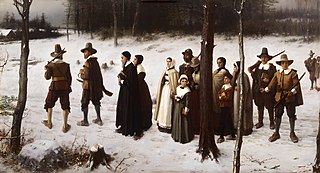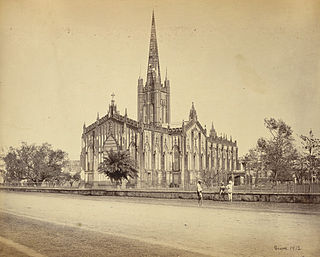In Anglican Christianity, low church refers to those who give little emphasis to ritual, often having an emphasis on preaching, individual salvation and personal conversion. The term is most often used in a liturgical sense, denoting a Protestant emphasis, whereas "high church" denotes an emphasis on ritual, often Anglo-Catholic.

The Church of North India (CNI) is the dominant united Protestant church in northern India. It was established on 29 November 1970 by bringing together most of the Protestant churches working in northern India. It is a province of the worldwide Anglican Communion and a member of the World Methodist Council and the World Communion of Reformed Churches. The merger, which had been in discussions since 1929, came eventually between the Church of India, Pakistan, Burma and Ceylon (Anglican), the Methodist Church, Disciples of Christ, and some congregations from the United Church of Northern India.

Bengali Christians are adherents of Christianity among the Bengali people. Christianity took root in Bengal after the arrival of Portuguese voyagers in the 16th century. It witnessed further conversions among the Bengali upper-caste elite during the 19th century Bengali Renaissance.
Protestants in Myanmar make up 5% of that nation's population in 2023. Most Christians are from the minority ethnic groups such as Karen, Lisu, Kachin, Chin, and Lahu. An estimated 0.1% of the Bamar population is Christian.

Protestant denominations arrived in the Philippines in 1898, after the United States took control of the Philippines from Spain, first with United States Army chaplains and then within months civilian missionaries.

Protestantism in Brazil began in the 19th century and grew in the 20th century. The 2010 Census reported that 22.2% of the Brazilian population was Protestant, while in 2020 the percentage was estimated to have risen to 31% of the population, over 65 million individuals, making it the second largest Protestant population in the Western world.

Christianity is a minority religion in Sri Lanka. It was introduced to the island in first century. Traditionally, after Thomas the Apostle's visit in Kerala in AD 52, Christianity is said to have been introduced to Sri Lanka because of its close geographical and commercial ties.

There are around 500,000 to 1,000,000 Protestants in Egypt, with 300,000 to 600,000 being members of the Evangelical Church of Egypt, Pentecostals number 300,000 to 350,000, and various other Protestants scattered in smaller denominations.

Protestants in Thailand constitute about 0.77% of the population of Thailand. Protestant work among the Thai people was begun by Ann Judson in Burma, who evangelized Thai war captives who were relocated to Burma. Protestantism was introduced to the country of Thailand in 1828 through the work of Karl Gutzlaff and Jacob Tomlin, the first two resident Protestant missionaries in Thailand.
The population of Angola is more than 92% Christian as of 2023.
Protestants in Japan constitute a religious minority of about 0.45% of total population or 600,000 people in 2020.

In Christianity, the ordination of women has been taking place in an increasing number of Protestant and Old Catholic churches, starting in the 20th century. Since ancient times, certain churches of the Orthodox tradition, such as the Coptic Orthodox Church, have raised women to the office of deaconess. While ordination of women has been approved in many denominations, it is still a very controversial and divisive topic.

Christianity in West Bengal, India, is a minority religion. According to the 2011 census of India, there were 658,618 Christians in West Bengal, or 0.72% of the population. Although Mother Teresa worked in Kolkata (Calcutta), Christianity is a minority religion in Kolkata as well. West Bengal has the highest number of Bengali Christians. Bengali Christians have been established since the 16th century with the advent of the Portuguese in Bengal. Later in the 19th and 20th centuries, many upper-class Bengalis converted to Christianity during the Bengali Renaissance under British rule, including Krishna Mohan Banerjee, Michael Madhusudan Dutt, Anil Kumar Gain, and Gnanendramohan Tagore. Aurobindo Nath Mukherjee was the first Indian to be Anglican Bishop of Calcutta.
Telugu Christians or Telugu Kraistava are a religious community who form the third-largest religious minority in the Indian states of Andhra Pradesh and Telangana. According to the 2001 Census of India, there are over a million Christians in Andhra Pradesh, constituting around 1.51% of the state's population. This is a decrease from the 1971 census figure which put the percentage of Christians in state as 2%, and this decrease is mainly a result of low birth rates and emigration.

Protestantism is the largest grouping of Christians in the United States, with its combined denominations collectively comprising about 43% of the country's population in 2019. Other estimates suggest that 48.5% of the U.S. population is Protestant. Simultaneously, this corresponds to around 20% of the world's total Protestant population. The U.S. contains the largest Protestant population of any country in the world. Baptists comprise about one-third of American Protestants. The Southern Baptist Convention is the largest single Protestant denomination in the U.S., comprising one-tenth of American Protestants. Twelve of the original Thirteen Colonies were Protestant, with only Maryland having a sizable Catholic population due to Lord Baltimore's religious tolerance.

The Church of India, Burma and Ceylon (CIBC) was the autonomous ecclesiastical province of the Anglican Communion, associated with the Church of England, in British India.












